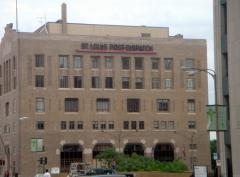The St. Louis Post-Dispatch

St. Louis Post-Dispatch building.
In 2008, the Post-Dispatch was one of the top 30 newspapers in the US by circulation, as well as one of the largest newspapers in the Midwest. [1] It served close to 300,000 weekday subscribers in 16 counties in Missouri and Illinois. The paper had a proud history as the first newspaper founded by Joseph Pulitzer, who bought the bankrupt St. Louis Post and merged it with the ailing St. Louis Evening Dispatch in 1878. [2] The Pulitzer family controlled the newspaper through three generations; when its primary competitor, the St. Louis Globe-Democrat , shut its doors in 1986, the Post-Dispatch became the only large daily in town.
In 2000, Pulitzer’s purchase of the weekly Suburban Journals of Greater St. Louis—a chain of more than 30 neighborhood-level newspapers—further consolidated the company’s print news hegemony in St. Louis. Under the stewardship of Chairman Michael Pulitzer, Pulitzer Publishing Company was also early to recognize potential in distributing news electronically. By the 1980s, its newspapers had already begun to experiment with delivering news via television and telephone. In the early 1990s, Pulitzer was one of the first to invest in the emerging technology of the Internet as personal computers (PCs) became cheaper and more common in American homes. In December of 1991—when there were around 50,000 PCs in the St. Louis area—the company launched PostLink. The venture was not an online version of the newspaper, but an “electronic information service” that delivered news briefs, stock quotes, forecasts, classifieds, and sports scores to computers for a flat fee of $9.95 per month. The company had only modest ambitions for the new service. In an article announcing PostLink’s launch, the newspaper declared that “the venture is not seen as a major business initiative but represents a field that the company wants to enter.” [3]

St. Louis
Throughout the 1990s and into the 21 st century, the Post-Dispatch like other newspapers struggled to create an online identity—a blend of text content, images, interactivity, and multimedia elements that could supplement the paper product without replacing it altogether. But it was unclear to many in the Post-Dispatch newsroom whether the Web, and its many opportunities for experimentation, would strengthen or undermine their journalism. Among reporters’ concerns, recalls Pat Gauen , Post-Dispatch public safety editor, was the fear that publishing stories for free online before the next day’s paper was printed meant “giving away” their work—primarily to television news stations. Gauen elaborates:
We were sort of parting with something we owned and giving it away earlier in the day. And there was a lot of raw resistance on the part of reporters, and some resistance on the part of me… We knew that the first four or five readers of our online product would be the TV stations and radio news operations here, and that they would harvest it for their own use. And our fear was that we’d have a good story on Monday afternoon for Tuesday’s paper, but by the time it got in Tuesday’s paper, the TV people would have grabbed onto it, and our readers would have seen it on TV at 5, 6 and 10, and by the time they saw it in the paper, they’d say, well, we already knew that… We’d end up scooping ourselves. [4]
Like other newspapers, the Post-Dispatch moved steadily toward providing its entire newspaper online, so that by the late 1990s, the newspaper was in effect reproducing a stripped-down version of its print product on the Web. But other newspapers were starting to treat their websites as separate products, not simply print in another medium. In 1997, the Knight Ridder chain created “portals” to accompany their online newspapers—guides to arts, culture, services, and jobs in the cities in which the chain owned newspapers. Philly.com, for example, was a portal to Philadelphia that supplemented the online Philadelphia Inquirer , and Boston.com served readers of the Boston Globe . [5]

The Post-Dispatch followed suit in March 2001 with STLtoday.com, which its president hoped would become “the definitive online guide to living in St. Louis.” The site—with its own staff of 65, housed outside the Post-Dispatch newsroom—radically deemphasized the newspaper itself. The online version of the newspaper was just one among many links in the portal, which also linked to other news sites such as the Associated Press.
But it soon proved unprofitable to treat STLtoday.com as an independent enterprise. Within a year, by March 2002, the Pulitzer Publishing Company had laid off 15 STLtoday.com staff members, and the site’s president resigned over the portal’s disappointing revenue. [6] A few months after that, STLtoday.com’s staff moved into the Post-Dispatch newsroom—the newspaper and the website were no longer separate operations.
[1] Audit Bureau of Circulations via Burelles Luce , “2008 Top Newspapers, Blogs & Consumer Magazines."
[2] Harry Levins, “Family’s newspaper tradition comes to an end,” St. Louis Post-Dispatch , January 31, 2005.
[3] Robert Sanford, “Pulitzer plans new computer service in fall,” St. Louis Post-Dispatch , August 1, 1991.
[4] Author’s interview with Pat Gauen, on June 23, 2008, in St. Louis, Missouri. All further quotes from Gauen, unless otherwise attributed, are from this interview.
[5] J.D. Lasica, “Gleaming Portal, Pauper News Site,” Online Journalism Review , March 22, 2001.
[6] Kathryn S. Wenner, “Pruning the Portal,” American Journalism Review , March 2002.